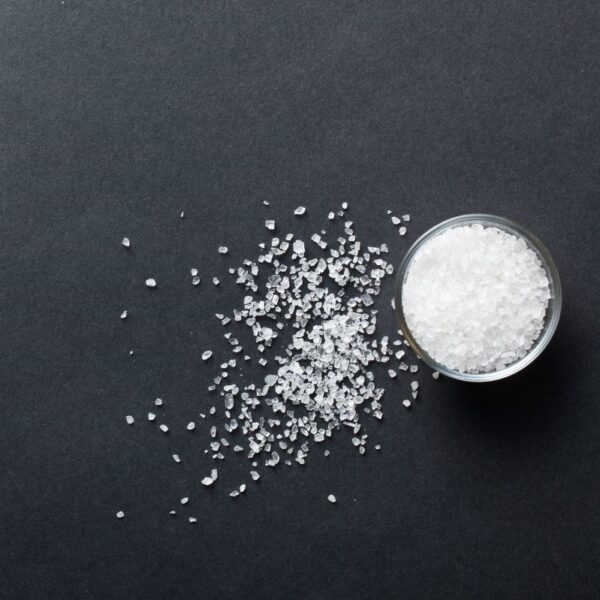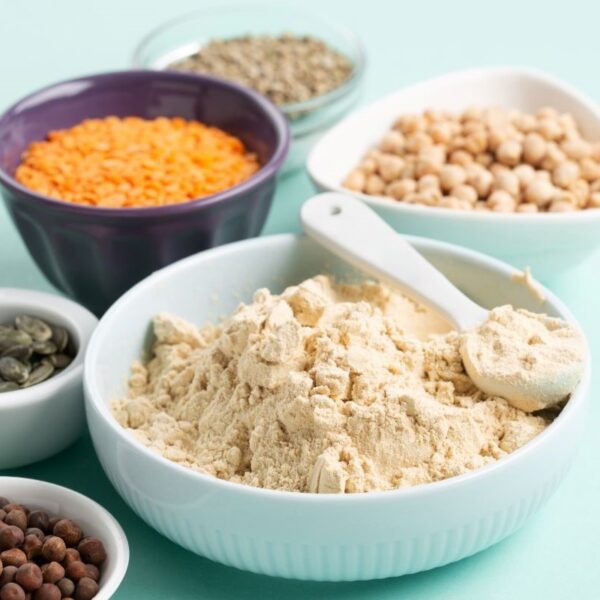Sodium caseinate – also known as casein sodium salt – is used in the food industry as an emulsifier, thickening agent, stabilizer, foaming agent, and binding agent. It is also used in nutrition products as a protein fortifier, with ~80-90% protein content.
What is Sodium Caseinate?
Sodium caseinate is a sodium salt derived from casein, a protein present in the milk of mammals. Sodium caseinate is commonly used in the food industry to improve the retention of fat in food and water, prevent syneresis, contribute to the uniform distribution of the various ingredients in food processing, as well as to improve the texture and taste of food.
Sodium caseinate can create and hold foam, absorb fat, and improve the nutritional aspects of food primarily by increasing the protein content in the finished product. Because it’s water soluble, it’s relatively easy to use in food formulations.
How is Sodium Caseinate Produced?
Sodium caseinate is produced by treating casein with a dilute sodium hydroxide solution and spray-drying the soluble material. Insoluble casein is converted into a soluble salt form.
Obtaining casein from milk can be accomplished using two methods:
- Acid Coagulation: Acid coagulation uses acidulants (e.g., lactic acid, acetic acid, hydrochloric acid, or sulfuric acid) to reduce the pH of the milk to the isoelectric point of casein (pH 4.6) to precipitate casein.
- Enzymatic Precipitation: Enzyme-rennet can be used to obtain the coagulated precipitate. Rennet is a complex set of enzymes. Chymosin protease from the rennet enzyme complex cleaves the kappa casein chain, removing the slightly negatively changed glycomacropeptide from the surface of casein micelle. The removal of charge causes casein micelles to cluster and precipitate.
Applications in Food & Nutrition
| Function | Applications |
| Emulsifier | The emulsification capabilities of sodium casein are due to the fact that casein is a protein with hydrophilic and hydrophobic groups of molecules. Sodium caseinate stabilizes emulsions made of hydrophilic and lipophilic substances. |
| Stabilizer | Sodium caseinate stabilizes food systems by both emulsification and thickening. |
| Binder | Sodium caseinate binds fat and water ingredients together. It improves yield and reduces moisture loss in food products. |
| Thickener & Bodying Agent | Sodium caseinate is a high molecular weight protein that has a certain viscosity in aqueous solutions. |
| Protein Source | Sodium caseinate is composed of 80-90% protein, making it a versatile protein source for food products. |
Product Examples
Food Products
| Category | Examples |
| Bakery | Bread, Cookies, Biscuits, Cake, Pastry |
| Dairy | Ice Cream, Yogurt, Sweet Meats, Dairy Whiteners, Dairy Creamers, Cream, Frosting, Whipped Toppings |
| Confectionery | Candies, Frozen Desserts, Whipped Toppings |
| Dairy Analogs | Imitation Cheese, Non-Dairy Creamer |
| Savory & Snacks | Snacks, Mayonnaise, Sauces, Gravies |
| Infant Foods | Infant Foods |
| Convenience | Cereal Products, Pasta, Noodles |
Nutrition Products
| Category | Examples |
| Functional Foods | Protein Bars, Protein-Fortified Food Products |
| Functional Beverages | Protein Shakes, High-Protein Beverages, Dairy-Based Protein Beverages |
| Dietary Supplements | Protein Supplements |
Properties of Sodium Caseinate
| Physical Form | Powder |
| Color | White to yellowish |
| Odor | Typical milk odor |
| Taste | Typical milk taste |
| Storage Temperature & Conditions | 2-8°C |
| Density | 1.1±0.1 g/cm3 |
| Molar Mass | ~ 314.440 g/mol |
| Viscosity | ∼0.93 mPa.s (0.1%) |
| Solubility (Water) | 50mg/ml |
| Claims (*Product Specific) | Halal*, Kosher*, Natural* |
Typical Formulations
Gluten-Free Bread
Here is an example of a gluten-free bread formulation table with sodium caseinate and the ingredients’ weight. Using sodium caseinate improves the product’s properties in terms of farinograph results, sensory evaluation, increased water absorption, dough yield, moisture retention, lightness of crumb, and redness index.
| Ingredient | Composition (wt. in gram) |
| Rice flour | 240 |
| Maize starch | 300 |
| Soy flour | 48 |
| Transglutaminase | 3 |
| Alpha amylase | 0.15 |
| Lipase | 0.15 |
| Guar gum | 12 |
| Xanthan gum | 5 |
| Carboxymethyl cellulose | 5 |
| Yeast | 60 |
| Inulin | 10 |
| Pregelatinized starch | 39 |
| Oil | 20 |
| Sugar | 27 |
| Salt | 15 |
| Datem | 10 |
| Sodium caseinate | 2- 4 % (total w/w) |
Source: IJCMAS
Ice Cream Mix (Dry)
Here is an example of an ice cream mix formulation table with sodium caseinate, along with the weight of ingredients:
| Ingredient | Composition (wt. in parts) | |
| Dry Mix (Spray-dried) | Lactose | 6 |
| Sodium caseinate | 3 | |
| Sugar | 4.5 | |
| Water | 45.5 | |
| Coconut oil | 18 | |
| Emulsifiers (Tween 65 & Tween 22, 1:1) | 0.3 | |
| Corn syrup (80% solids) | 6 | |
| Ice-cream | Dry Mix | 740.5 |
| Sugar | 592.6 | |
| Lactose | 130 | |
| Carrageenan | 15 | |
| Salt | 10 | |
| Vanilla flavor, imitation | 6.9 | |
| Imitation butter vanilla flavor | 3.1 | |
| Yellow color | 0.1 | |
| Water | 3000 |
Source: Google Patents
Edible Food Coating
Here is an example of a food coating formulation table with sodium caseinate and the ingredients’ weight. This coating was used for the post-harvest coating of Bing cherries. The coating reduced water loss of the fruits, delayed darkening and softening, and imparted beneficial effects on sensory properties such as firmness and appearance.
| Ingredient | Composition (weight in g) |
| Sodium caseinate | 50 |
| Glycerol | 15 |
| Beeswax | 15 |
| Stearic-palmitic acid mix | 15 |
| Water | 450 ml |
Source: Wiley
Sodium Caseinate Formulation Considerations
Several factors must be considered when formulating food and nutrition products with sodium caseinate.
Difference from Micellar Casein
Micellar casein is the gold standard for protein powder since it provides native casein micelles. A casein micelle is a colloidal particle found in milk that allows casein protein and its associated calcium-phosphate complexes to be soluble in the liquid phase. Micellar casein protein is a rich source of calcium and phosphorus. Sodium and calcium caseinate, on the other hand, are salts of casein.
Effect on Nutritional Properties
Casein is a high-quality, slowly digested protein that supports muscle recovery and growth. It is also rich in calcium and bioactive peptides that may lower blood pressure and can help one feel full for longer. The general composition of sodium caseinate is >88% protein, <1% lactose, <5% ash, <2% fat, and <8% moisture, all of which vary slightly by manufacturer.
Effect on Texture
Sodium caseinate significantly affects the texture of food products in different ways.
- It can form anisotropic transglutaminase-induced gels under applied pressure.
- Sodium caseinate binds fat and water, increasing yield and reducing sausage shrinkage. It makes the fat distribution uniform and enhances the adhesion properties of meat. It can improve the elasticity as well.
- It has been shown to improve the texture of whipped cream by increasing the foaming and improving foam hardening properties.
Effect on Consistency and Mouthfeel
- In ice cream, using sodium caseinate helps keep products stable and prevents sugar condensation and contraction. It also improves the freeze-thaw stability of ice cream. In a study, sodium caseinate contributed to enhanced overrun in ice cream. Still, it resulted in an emulsion that was too stable to produce the desired degree of fat destabilization upon ice cream manufacture.
- The addition of salts to sodium caseinate solution has a significant impact on its viscosity. Sodium caseinate solutions with added monovalent cations formed thermo-reversible gels. The apparent viscosity of sodium caseinate solutions increased with divalent salt cations. Increasing the salt concentration above that necessary increase led to decreased viscosity due to precipitation.
- Combining sodium caseinate with certain thickeners, including carrageenan, guar gum, and CMC, can greatly improve its thickening and suspension stability. Carrageenan provides exceptional synergy, increasing viscosity and improving emulsification.
Encapsulation
Casein can form a thicker interfacial layer of 10 nm around lipid droplets than whey proteins at 1-2 nm. In addition, casein is easily degraded in gastric enzymes because of its open tertiary structure (due to high proline content) to release encapsulated materials.
Sensory Properties
Sodium caseinate overall has a very bland flavor profile. It has been noted to be slightly sweet and overall neutral. The mouthfeel of sodium caseinate is thick and foamy.
Dosage
Depending on the category and variant, sodium caseinate is used at dosages of 0.1-2% or more in food products.
Safety & Regulatory Considerations
| FDA Information | As per the JECFA, the ADI (Acceptable Daily Intake) for sodium caseinate is not limited, and it can be regarded as food.. |
| Joint FAO/WHO Expert Committee on Food Additives (JECFA) | The European Food Safety Authority defines edible caseinate as a milk product obtained using edible casein or curd coagulum with neutralizing agents, followed by drying. Caseinates obtained using neutralizing agents such as sodium, potassium, calcium, magnesium, and ammonium salts are authorized to be used as food additives. |
| EU Information | The European Food Safety Authority defines edible caseinate as a milk product obtained using edible casein or curd coagulum with neutralizing agents, followed by drying. Caseinates obtained using neutralizing agents such as salts of sodium, potassium, calcium, magnesium, and ammonium are authorized to be used as food additives. |
Labeling
Because caseinate is one of the key components of dairy substitutes, its usage carries labeling requirements. As per the FDA, when foods labeled as “non-dairy” contain a caseinate ingredient, the ingredient must be followed by a parenthetical statement identifying its source. For example, suppose the manufacturer uses “non-dairy” on a creamer containing sodium caseinate. It must include a parenthetical term such as “a milk derivative” after listing sodium caseinate in the ingredient list.
Identification Numbers
| Name | Sodium caseinate |
| CAS Number | 9005-46-3 |
| EC Number | 618-419-8 |
Fun Facts About Sodium Caseinate
- Unlike many other proteins, casein is not coagulated by heat at low temperatures but by a chemical reaction.
- Sodium caseinate is remarkably heat stable at pH = 6.5.
Additional Resources
- PubChem – Sodium Caseinate
- IFT – Formulating and Manufacturing Ice Cream and Other Frozen Desserts
- ScienceDirect – Sodium Caseinate as a Foaming Agent in Ice Cream
- Agrocomplex – Applications and Uses of Sodium Caseinate
- CORE – Sodium Caseinate-Based Edible Coatings
- SpringerLink – Influence of Sodium Caseinate on Texture and Sensory Properties of Ice Cream
- Yesraj Agro Exports – Calcium Caseinate and Sodium Caseinate









